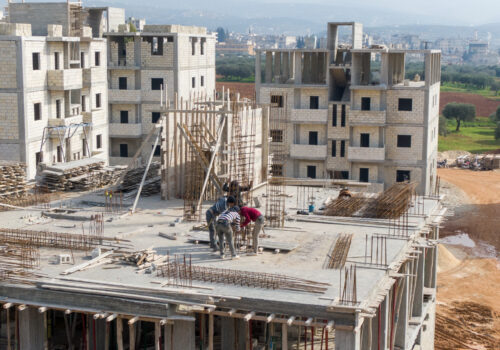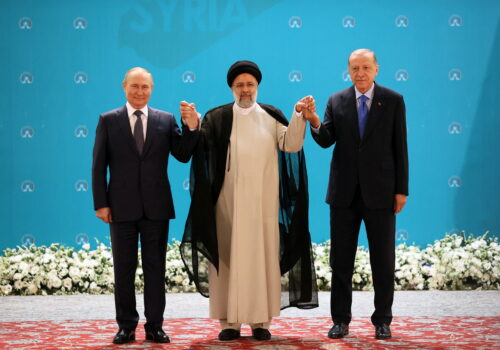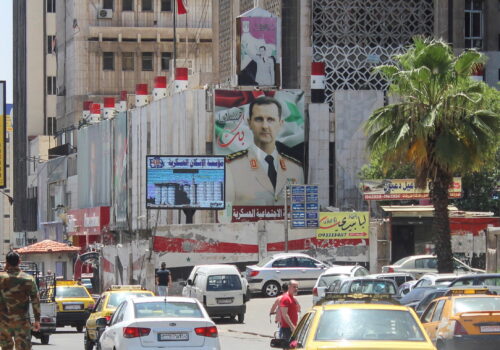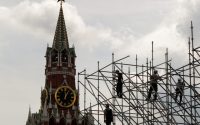From rebel factions to an army: Efforts to tame the Syrian National Army
While some elements that constitute the Syrian National Army (SNA) have moved away from their revolutionary foundations and turned into a contractor structure for Turkey’s foreign operations across various regional conflicts, others are trying to transform into an organized army under civilian leadership. Although the SNA’s previous attempts at institutionalization and reform through coalitions of factions have failed, its current transformation looks different.
The SNA, the northern Aleppo-based factions’ military structure, was established in 2017 to lead Turkey’s counterterrorism missions in Syria against the Islamic State of Iraq and al-Sham (ISIS) and the People’s Defense Units (YPG), the Syria branch of the Kurdistan Workers Party (PKK). The coalition included a mix of groups and fighters, some of whom fought against the Bashar al-Assad regime since 2011, while others joined Turkey’s counterterrorism mission in 2016. Over time, the SNA not only managed to dominate the military scene in areas liberated from ISIS and the YPG, but also became an important component of Turkey’s military missions in Libya, Azerbaijan, and, reportedly, in Niger.
Reforming the SNA—viewed in some quarters as a military subcontractor or proxy for Ankara—is doubly challenging given protracted wartime conditions and the fact that survival against local competitors and self-interest under those conditions leaves scant room for reform or ideological formation.
SIGN UP FOR THIS WEEK IN THE MIDEAST NEWSLETTER
The transformation of the SNA is part of Turkey’s plan to transform the areas it controls into a self-sufficient political-military structure that would protect Ankara’s national security interests and, perhaps, improve the Syrian opposition and Turkey’s leverage in any future settlement. The transformation would also ease the pressure on Ankara, which has been criticized for the SNA’s behavior, and would put the opposition’s Syrian Interim Government (SIG) at the center of the relationship with Turkey. This can be interpreted as Ankara’s intention to change its relationship with the Syrian opposition in the international arena. The empowerment of such a structure, theoretically led by the SIG, cannot be done without taming the SNA’s fragmented military structure, whose leaders have become contractors.
De facto local bodies and the challenges of creating space for the SIG
For nearly two years, Ankara has been implementing its plan to strengthen the SIG and bring order and stability to the SIG-held areas in northern Aleppo step by step, albeit slowly—despite the SNA’s resistance. The reform of the SNA aims to link the legitimate ground with a legal concept that comes from civilian government: loyalty to legislative and executive power. This would also change the perception of the Syrian opposition as an “entity dominated by armed groups.” In this way, transforming the SNA into an army with a clearly defined legal structure under its leadership would provide an internal balance to Syria’s opposition. Ultimately, the aim is to reduce the dominant role of the SNA and transform the Syrian opposition, particularly the SIG and all other civilian sectors, into an autonomous political actor.
In 2018, the SIG established a military judiciary mechanism to hold SNA groups accountable by adopting a military code in line with humanitarian law norms and setting up a military police force as the mechanism’s law-enforcement agency. According to Arafat Hammoud, the prosecutor in charge of military judicial administration, 433 members of the SNA were indicted and sentenced on various charges between January and May 2023 and have already been sentenced. Hammoud said that civilians who believe that SNA soldiers have committed crimes can appeal to the military judiciary. Independent reporting from human rights organizations does not yet confirm the impact of these reforms. Local civil society leaders are satisfied in principle, though they say that some SNA factions have gone beyond the limits set by the reforms and have been involved in various crimes. For the tribes, which have often had problems with the SNA, the aforementioned reforms will improve public safety and security by forcing the SNA to act within the limits of the law.
In 2023, the military judiciary mechanism gave the death penalty to four SNA soldiers who deliberately killed four people during the 2023 Nowruz holiday. Although all death sentences have been suspended, this symbolic punishment also shows that the SIG will not hesitate to confront the SNA as part of the structural reforms.
The challenge for the SIG, however, is that SNA leaders are unlikely to suddenly relinquish the financial, military, and political power they gained over the past decade. Meanwhile, small groups within the SNA seem more attentive to the SIG’s reforms. Per my research, in the northern Afrin region, a quasi-democratic spontaneous local system has been established between the Kurdish, Yazidi-Kurdish, and Alevi-Kurdish communities and small groups of SNA components controlling relatively small areas.
Committees established between small SNA groups and the local population have solved the issues practically, without waiting for a centralized organization. For example, according to the interviews I conducted in the village of Darwisha, north of Afrin, a committee was established to resolve the disputes between the SNA factions and the Kurdish population in the village, which concerned olive groves and the return of the Kurdish population displaced because of the conflict. While it did not confiscate the olive groves or the houses of the displaced, villagers told me the SNA only agreed to pay taxes for olive production for one year. The village’s needs, such as a well to draw water for the water-supply network, were resolved similarly. However, this approach, which consists of mutual promises, has no traditional or legal basis and varies from village to village.
In a way, this local system is laying the groundwork for the structural reform being implemented by the SIG through the smaller revolutionary groups in the SNA. However, it is also known that the SNA often abolished this spontaneous structure, which was established with the experiences of the first years of the revolution, by intervening in in line with the faction’s interests. This is because a protective or constitutive law does not shape these de facto structures but only by mutual understanding and power at the mercy of the SNA. Yet, the small groups of the SNA that have tried to preserve their revolutionary character are transferring the experience of local self-government to these structures.
Progress despite structural problems
Between the levels of factions’ pragmatism and senior officials of the SIG and its defense ministry lies a diffuse network of power brokers who lack incentives to consent to systematic military reform. A centralized military structure, completely withdrawn from the civilian sphere and subordinated to the SIG, is not in the interest of some powerful factions within the SNA. In contrast to these groups, whose military presence is the basis of their economic and political influence, other smaller groups have shown greater openness to centralization.
This is already evident in the periodic and operational alliances that some factions have formed among themselves, not within the formal structure of the SNA. In this context, coalitions such as the Joint Force and Tahrir and Construction Movement within the SNA, which are based on economic and influence competition between leaders rather than politics, are among the issues that the SIG should address.
Here, naturally, the issue of the SIG’s arm wrestling with the SNA comes up—namely the issues of authority and power. The SIG is not a bottom-up organization nor an elected government whose will is derived from the people of the regions it governs. The SNA has a closer relationship with the population in areas of northern Aleppo and, in this respect, the SIG lacks the mass influence of SNA leaders.
Despite the obvious structural needs to implement centralized policies, the reforms that the SIG has so far implemented through its defense ministry have been functional due to the support of Turkey, which provides the economic and military backbone for areas under SIG administration. The withdrawal of SNA components from civil, economic, judicial, and law-enforcement functions—as well as the cessation of its military power to act contrary to judicial decisions and laws, and the reduction of its influence over the masses and the media—will not happen overnight. But with the support and encouragement of Turkish authorities, these things might occur over time.
Although the SIG and the defense ministry have established various institutional committees, such as the Military Advisory Council, they have so far failed to deter the SNA leaders with military power. However, the council provides a potential mechanism to make fast and fair decisions on SNA issues. In the medium term, it is safe to assume that the military council, the military judiciary, and the military police will become effective institutionalizing forces.
The military police, established due to the inter-factional conflicts within the SNA, has come a long way since 2018. Military Police took over checkpoints set up on the roads by military groups, because SNA factions often imposing themselves instead of public order in SNA-controlled areas. The military police have also taken control of the crossing gates to the YPG and the regime areas, centralizing humanitarian crossings. In this respect, it must be said that the military police, together with the Border Protection Brigades, have been very effective in reducing illegal crossings into Turkey from YPG- and regime-held areas.
The institutionalization of the military police, including the military judiciary and the defense ministry’s takeover of the crossing points and customs gates from the SNA on behalf of the SIG, also changed the economic rivalry that often led to internal conflicts within the SNA. SNA revenues were centralized and placed under the control of the defense ministry through the SIG budget.
While these institutionalization efforts and the functioning of military law have not yet reached the desired level, they show that the SIG is working to separate civilian and military status and to civilianize the administration from the municipalities to the government. In other words, although it is not emphasized, in the long run the process of change in northern Syria will paint a picture of whether the Syrian opposition is ready for solutions and whether it can be an alternative to the Assad regime.
SNA reforms, led by the SIG and supported by Turkey, will expand beyond the military sphere to the public sphere and civil society. The ultimate goal of reforming the SNA, which dominates the political, economic, and social spheres with its military power, is to create space for a self-sufficient political actor that organizes public policies. Withdrawing the SNA from the political sphere and turning it into a defense force under the rule of law will pressure the SIG to become a civilian political body subject to local and general elections. This might also take the governance situation in northern Syria to a higher level than the predicted rebel quasi-state phase. One of the medium- to long-term benefits of this process will be the confidence that the civilianized public sphere will offer to economic investors. This process may allow the SIG-administered areas, where the conflict has largely moved away from the civilian sphere, to attract small-to-medium investors and combat poverty and unemployment.
Levent Kemal is a freelance journalist and researcher based in Istanbul.
Further reading
Tue, Jun 4, 2024
Economic recovery in opposition-held Syria is challenging but still possible
MENASource By Sinan Hatahet
The United States and its allies can foster an early recovery in opposition-held areas without undermining the UN-led political resolution efforts.
Thu, May 9, 2024
Syria holds the key to improved US-Turkey ties
MENASource By Ömer Özkizilcik
It is crucial that the United States and Turkey overcome their differences because the governments need to strengthen their alliance—especially as it concerns Syria.
Thu, Apr 25, 2024
The Syrian parliamentary elections are coming up. Should anyone care?
MENASource By Vladimir Pran and Maroun Sfeir
The polls will be held again against a backdrop of massive displacement, unresolved conflict, partial occupation, and an intransigent regime.
Image: Members of Syrian National Army, known as Free Syrian Army, stand on top of an armored vehicle in the Turkish border town of Ceylanpinar in Sanliurfa province, Turkey, October 11, 2019. REUTERS/Murad Sezer




